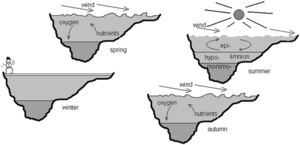Meromictic lake: различия между версиями
| Строка 1: | Строка 1: | ||
| − | [[Файл:Sketch of stratification and recirculation in a meromictic lake over an annual cycle.png|альт=Стратификация в меромиктическом озере в течение года|мини|300x300пкс|Sketch of stratification and recirculation in a meromictic lake over an annual cycle<ref>Boehrer | + | [[Файл:Sketch of stratification and recirculation in a meromictic lake over an annual cycle.png|альт=Стратификация в меромиктическом озере в течение года|мини|300x300пкс|Sketch of stratification and recirculation in a meromictic lake over an annual cycle<ref>Boehrer Bertram; von Rohden C.S.M. Physical Features of Meromictic Lakes: Stratification and Circulation // Springer. – 2017. – Vol. 228. – P. 15-34.</ref><br /><br />]] |
==Меромиктическое озеро== | ==Меромиктическое озеро== | ||
| Строка 5: | Строка 5: | ||
==Определение на английском== | ==Определение на английском== | ||
| − | A '''meromictic lake''' is a lake which has layers of water that do not intermix.<ref name=":1">Wetzel R. G. Limnology: Lake and River Ecosystems | + | A '''meromictic lake''' is a lake which has layers of water that do not intermix.<ref name=":1">Wetzel R.G. Limnology: Lake and River Ecosystems. Vol. 37. – 2001.</ref> In ordinary, holomictic lakes, at least once each year, there is a physical mixing of the surface and the deep waters.<ref name=":0">Lewis Jr. W.M. A Revised Classification of Lakes Based on Mixing // Canadian Journal of Fisheries and Aquatic Sciences. – 1983. – Vol. 40. – № 10. <nowiki>https://doi.org/10.1139/f83-207</nowiki>.</ref> |
| − | The term ''meromictic'' was coined by the Austrian Ingo Findenegg in 1935, apparently based on the older word ''holomictic''. The concepts and terminology used in describing meromictic lakes were essentially complete following some additions by G. Evelyn Hutchinson in 1937.<ref>Hutchinson G. E. Fundamentals of Limnology // | + | The term ''meromictic'' was coined by the Austrian Ingo Findenegg in 1935, apparently based on the older word ''holomictic''. The concepts and terminology used in describing meromictic lakes were essentially complete following some additions by G. Evelyn Hutchinson in 1937.<ref>Hutchinson G.E., Ruttner F., Frey D.G., Fry F.E.J. Fundamentals of Limnology // The Journal of Wildlife Management. – 1953. – Vol. 17. – № 3. <nowiki>https://doi.org/10.2307/3797125</nowiki>.</ref> |
==Пример использования термина на английском языке== | ==Пример использования термина на английском языке== | ||
| − | The lake is meromictic and during the period of study had an average salt gradient of approximately 100 g/liter at the surface to 400 g/liter at the bottom, the major salt being magnesium sulfate<ref> | + | The lake is meromictic and during the period of study had an average salt gradient of approximately 100 g/liter at the surface to 400 g/liter at the bottom, the major salt being magnesium sulfate<ref>Anderson G.C. Some Limnological Features of a Shallow Saline Meromictic Lake // Limnology and Oceanography. – 1958. – Vol. 3. – № 3. <nowiki>https://doi.org/10.4319/lo.1958.3.3.0259</nowiki>.</ref> |
==Перевод использования на русском языке== | ==Перевод использования на русском языке== | ||
Версия 01:48, 8 декабря 2021
Меромиктическое озеро
Меромиктическим называют озеро, частично перемешивающееся вследствие конвекции или ветрового воздействия до некоторой глубины, на больших глубинах чаша озера заполнена более минерализованной и плотной водой[2]
Определение на английском
A meromictic lake is a lake which has layers of water that do not intermix.[3] In ordinary, holomictic lakes, at least once each year, there is a physical mixing of the surface and the deep waters.[4]
The term meromictic was coined by the Austrian Ingo Findenegg in 1935, apparently based on the older word holomictic. The concepts and terminology used in describing meromictic lakes were essentially complete following some additions by G. Evelyn Hutchinson in 1937.[5]
Пример использования термина на английском языке
The lake is meromictic and during the period of study had an average salt gradient of approximately 100 g/liter at the surface to 400 g/liter at the bottom, the major salt being magnesium sulfate[6]
Перевод использования на русском языке
В течение периода исследования концентрация соли в меромиктическом озеро изменялась от 100 г/л на поверхности до 400 г/л на дне, причем основной солью был сульфат магния
Список литературы
- ↑ Boehrer Bertram; von Rohden C.S.M. Physical Features of Meromictic Lakes: Stratification and Circulation // Springer. – 2017. – Vol. 228. – P. 15-34.
- ↑ Эдельштейн К. К. Лимнология. Москва: Юрайт, 2019. Вып. 2. 1–386 с.
- ↑ Wetzel R.G. Limnology: Lake and River Ecosystems. Vol. 37. – 2001.
- ↑ Lewis Jr. W.M. A Revised Classification of Lakes Based on Mixing // Canadian Journal of Fisheries and Aquatic Sciences. – 1983. – Vol. 40. – № 10. https://doi.org/10.1139/f83-207.
- ↑ Hutchinson G.E., Ruttner F., Frey D.G., Fry F.E.J. Fundamentals of Limnology // The Journal of Wildlife Management. – 1953. – Vol. 17. – № 3. https://doi.org/10.2307/3797125.
- ↑ Anderson G.C. Some Limnological Features of a Shallow Saline Meromictic Lake // Limnology and Oceanography. – 1958. – Vol. 3. – № 3. https://doi.org/10.4319/lo.1958.3.3.0259.
